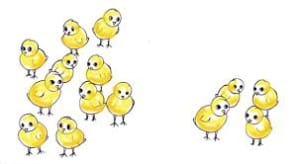How Many Students Should Be in a Small Group?
Posted by Brainspring on 13th May 2015
We all know that struggling readers need intensive intervention, beyond what a teacher is able to do when differentiating classroom instruction. We know that intervention instruction should be given to these students in small groups.
What we sometimes don’t know is how to accomplish this. I’ve seen many different approaches to intervention while working with diverse schools and teachers in multiple states. Some have been exemplary; some have been less than ideal.
There is not one set system for intervention or one set way to implement the RTI model; it’s flexible by design so schools can develop a process that works for their schedule and their students.
Although the model is flexible, there are guidelines and components that need to be included to make the intervention effective. Small groups are an essential piece of intervention instruction for struggling readers. Today I’ll try to answer a basic question about small groups that I get asked a lot - How many students should be in a small group?
How Many Students Should Be in a Small Group?
As an interventionist, I usually worked with small groups of 4-5. Many of the teachers I work with now, as an instructor and coach for Phonics First, say their small groups are usually 4-6. Sometimes an interventionist is lucky enough to only have 2-3 in a group. On the other hand, I have also seen schools where 8 or 15(it’s true!) are considered small group sizes.
So what’s the right number?
The design of the intervention model and most research suggests small groups should be no more than 6 students. A Principal’s Guide to Intensive Reading Interventions states: “Intensive interventions work best when they are provided in groups of no more than 3-5 students.” (If you have a few minutes, read through the entire guide. It’s only 7 pages and provides an easy-to-understand overview of how the intervention model is supposed to work.)
This question over small group size must be a common one because I found a response to a state department of education supplying relevant research to this very question.
- The National Comprehensive Center for Teacher Quality found that the results of small group instruction in groups of 3-6 were comparable to the results of one-on-one instruction.
- The National Research Center on Learning Disabilities made these recommendations for small groups: “Small group interventions should a) include 2 to 4 students per group; b) have 3 to 4 interventions; c) last 30–60 minutes per week; c) for a duration of 9–12 weeks.”
- The study done for the research paper “Reading instruction grouping for students with reading difficulties” by Vaughn, S., Linan-Thompson, S., Kouzekanani, K., Bryant, D. P., Dickson, S., & Blozis, S. (2003), found that students in a group of 10 failed to make minimal gains, while interventions with students in groups of 3 and one-on-one were highly effective.
Taking all these results into account suggests that small groups are most effective when there are 3-6 students. The research paper makes it clear that an intervention’s effectiveness drastically decreases with larger group sizes. The research also seems to indicate that small group instruction can be just as effective as individual instruction in many cases.
Misconceptions About Small Groups
There are several misconceptions about small group instruction that can hinder its effectiveness. Addressing these misconceptions is important to ensuring educators understand the value of maintaining appropriately sized groups for interventions.
Misconception 1: Larger Groups Can Achieve the Same Results as Smaller Groups
One of the most common misconceptions is that grouping more students together can yield similar results as smaller groups, especially if the teacher is experienced. However, research shows that larger groups dilute the individualized attention students receive. When too many students are in a group, struggling readers often get left behind as the instructor focuses on addressing the majority's needs.
Misconception 2: Small Groups Are Only Necessary for Younger Students
Some educators assume that small groups are primarily beneficial for early elementary grades. While younger students may benefit more from small group instruction as they learn foundational skills, older students with reading difficulties also need this approach. Small groups provide a supportive environment for interventions, regardless of age or grade level.
Misconception 3: Small Groups Require One-On-One Attention to Be Effective
While one-on-one instruction is beneficial in some cases, research suggests that groups of 3-6 students can produce comparable results. Small groups also foster collaboration and peer learning, which can improve comprehension and engagement. Teachers can use peer support to reinforce concepts while still providing individualized feedback.
By addressing these misconceptions, educators can better implement small group instruction, and meet the specific needs of their students
I linked to the sources within the post, but I’m including them here as well for any teacher looking for evidence to take to their principal or administrator.
http://www2.ed.gov/programs/readingfirst/support/principal.pdf
http://secc.sedl.org/orc/rr/secc_rr_00076.pdf
What other questions do you have about the intervention model or RTI?
Remember to like us on FB, follow us on Twitter and share us with your friends!

